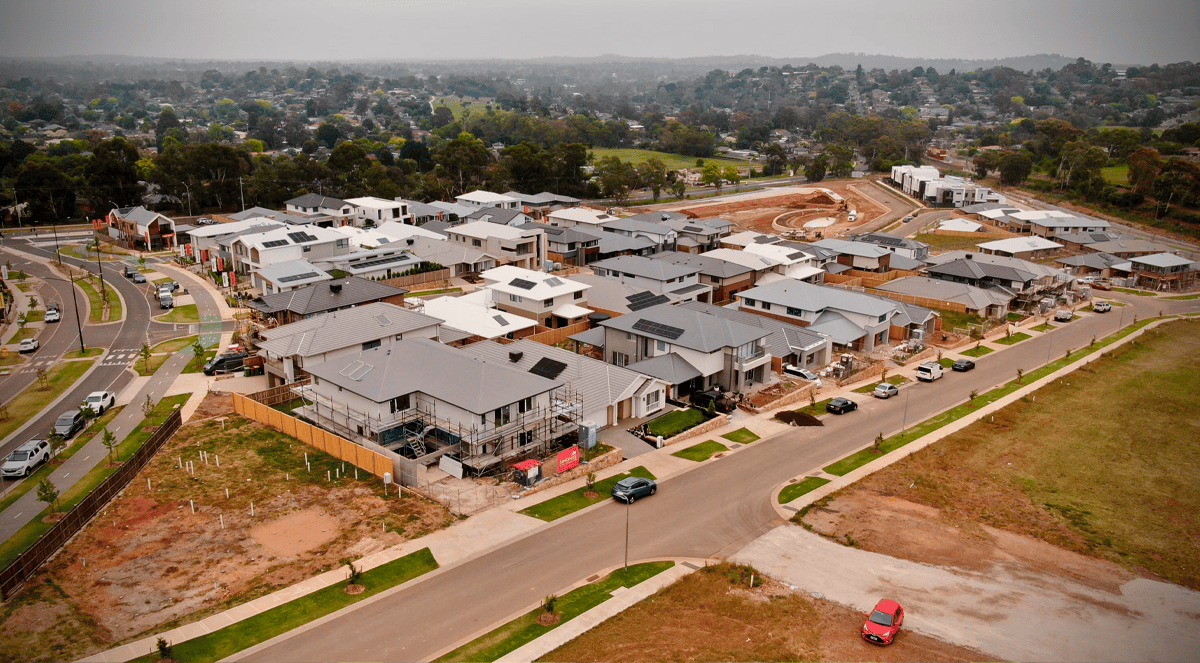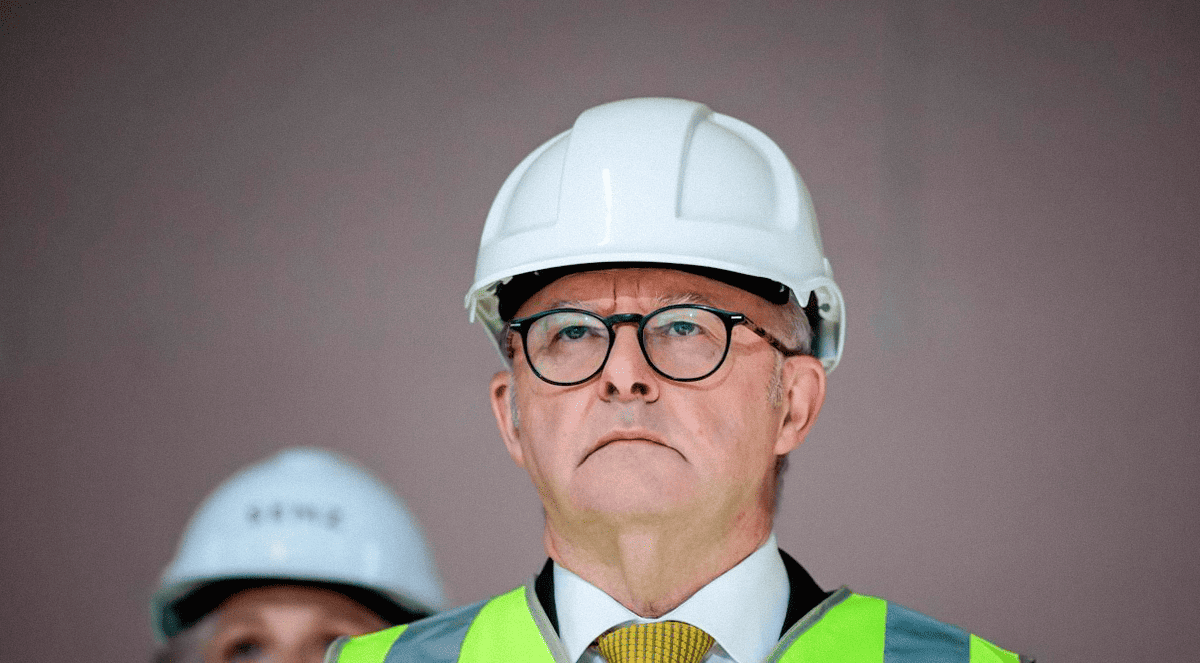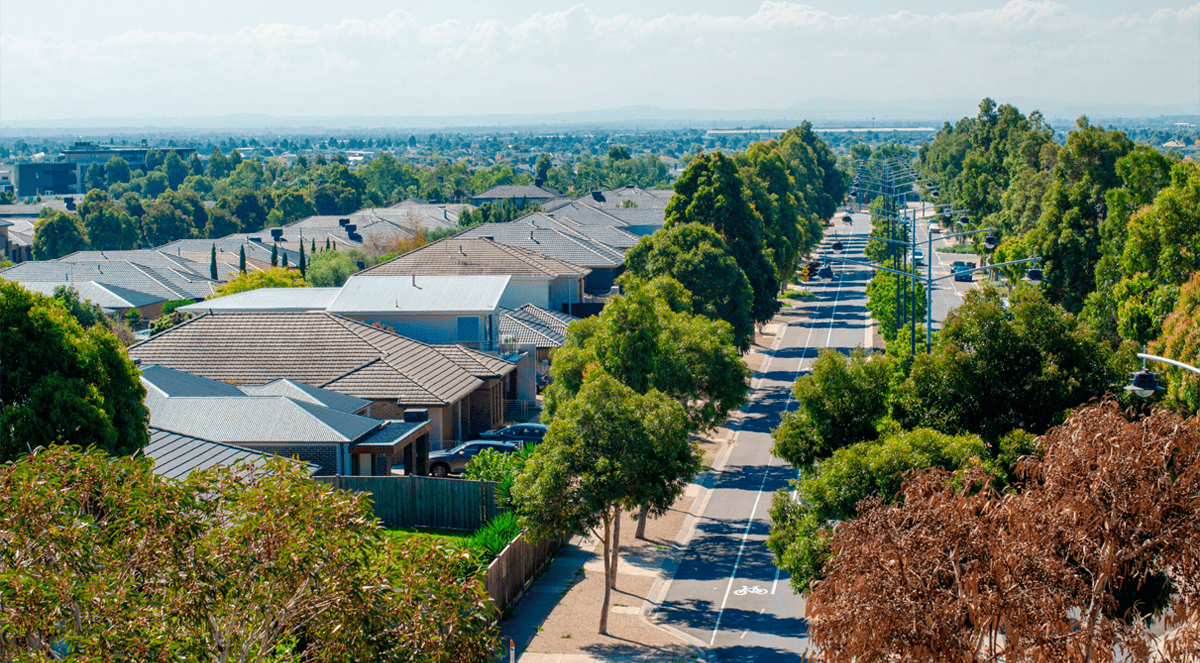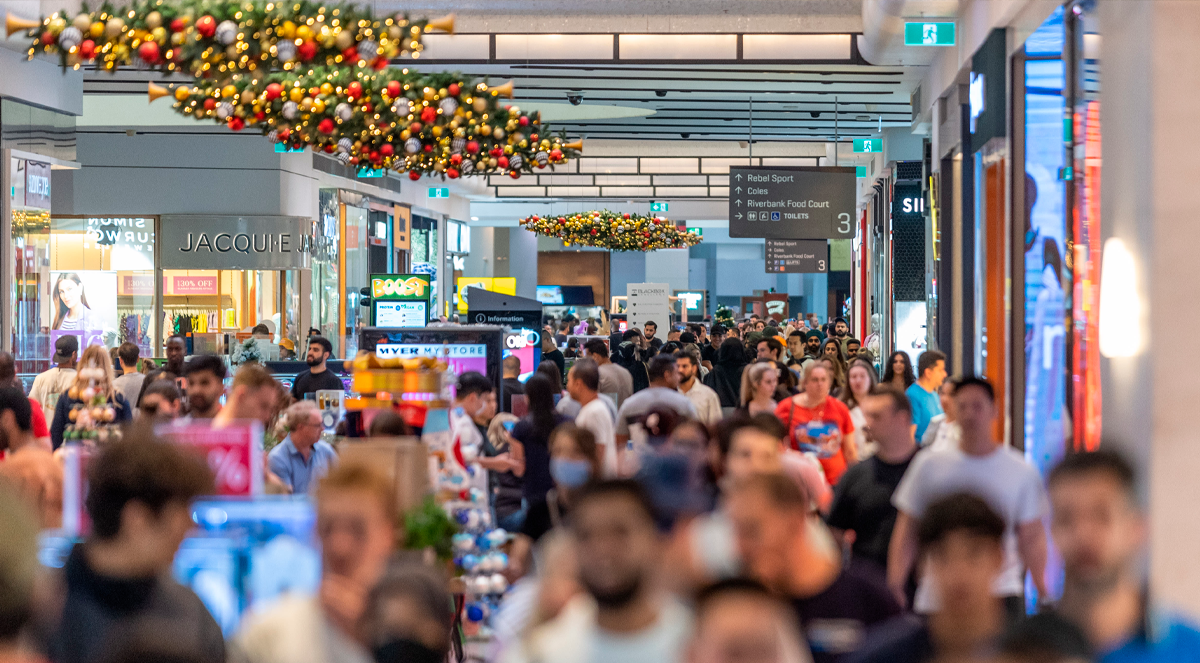Features > Property News & Insights > Market updates
Home values growing at the fastest rate in more than two years

Image from ABC News
KEY POINTS
- Australian home values rose 1.1% in October 2025, the fastest in over two years, lifting annual growth to 6.1%, with lower- and mid-priced homes leading amid the expanded 5% deposit guarantee
- Despite higher inflation dimming prospects for more cuts, demand remains strong and supply tight, with listings 18% below average and sales 3.1% above the five-year norm
- Low national vacancy rates are also driving rents higher, up 0.5% per month in recent months, led by Darwin (+8.5%) and Hobart (+6.9%)
Australian home values are accelerating at their fastest rate in more than two years, chalking up national gains of 1.1% in October 2025, the sharpest monthly increase since June 2023.
The latest monthly data from property analytics firm Cotality confirms price momentum has strengthened since the Reserve Bank of Australia began cutting interest rates in February this year, lifting the annual pace of home value growth to 6.1% nationally.
The central bank has cut the cash rate twice more, in May and August, for a combined reduction of 0.75%.
While recent higher-than-expected inflation data may have pushed back or even ended the prospect of further rate cuts, Cotality points to ongoing strong demand for housing in the face of tight supply.
The details
“Before the February rate cut, housing conditions were losing momentum, even recording flat to falling values through late 2024 and January 2025,” says Tim Lawless, Cotality’s Research Director.
“The first rate cut in February marked a clear turning point, with home values moving through a positive inflection across most regions and gathering steam since then.”
Cotality’s Home Value Index for October 2025 shows every capital city and regional market recorded a rise in values - from a 1.9% surge in Perth to a more modest 0.3% lift in Hobart.
Brisbane also leapt ahead by 1.8% during October.
At $992,864, the median home in the Queensland capital is set to pass the $1 million mark by the end of the year.
Sydney recorded a solid 0.7% lift (taking annual growth there to 4%) to reach a new record median home value of $1,256,156.
Melbourne accelerated to 0.9% growth for the month, taking the city to a median dwelling value of $818,975.
On Cotality’s calculations, the Victorian capital - which has recorded sub-par growth for several years - is now just 1.4% below the record median value it recorded in March 2022.
Across the combined capitals, the October increase equates to more than $10,000 added to the value of a median home.
Looking back further, since the first RBA rate cut in February, Cotality estimates capital city dwelling values are up 5.9%, or around $53,700 on average.
Cotality’s data also points to demand continuing to outstrip supply.
Nationally, home sales are running 3.1% above the five-year average, while advertised listings remain 18% below typical levels.
Cotality says these tight conditions have tilted the market heavily in favour of sellers.
While auction clearance rates have softened slightly, they remain well above the decade average, hovering in the high 60% to low 70% range.
Lower-priced homes leading the charge
The expansion of the federal government’s 5% deposit guarantee scheme, which took effect on October the 1st, has likely added to demand among first-home buyers and lower-income households.
“The upper quartile of the market is showing the lowest rate of growth across almost every capital city,” says Cotality’s Tim Lawless.
“Stronger housing demand at the lower price points is likely a culmination of serviceability constraints eroding purchasing power, persistently higher than average levels of investor activity, and what is likely a pickup in first-home buyers taking advantage of the expanded deposit guarantee.”
Across the combined capitals, middle-market values rose 1.4%, the lower quartile gained 1.2% and the upper quartile increased 0.7% through October.
Regional markets also posted strong results, with values up 1.0% nationally; the largest monthly increase since March 2022.
Regional Western Australia led with a 1.8% rise, followed by Regional Queensland (1.1%) and Regional NSW (1.0%).
Renewed rental pressures
Meanwhile, record-low vacancy rates of around 1.4% are pushing rents higher once again.
Cotality’s national rental index rose 0.5% per month over the past three months, the steepest pace of growth since May 2024.
After slowing last year, annual rental growth is back on the rise, led by the smaller capitals.
Darwin rents are up 8.5% over the past year, while Hobart is up 6.9%.
Unit rents are also rising faster than houses, climbing 4.4% compared to 3.9% for houses, adding roughly $28 a week and $27 a week respectively, to median rents over the past 12 months.
The outlook
Mr Lawless says the housing outlook remains finely balanced, with strong demand colliding with affordability and renewed inflation pressures.
“There are a lot of moving parts influencing the housing market at the moment,” he says.
“On one hand, we have persistently low levels of advertised supply and above-average levels of housing demand supporting value growth.
“On the other hand, we suddenly have a renewed inflation challenge and the prospect of a shallower rate-cutting cycle.”
He noted that major banks have revised their rate forecasts, with “CBA going further, forecasting no more cuts in this cycle.”
With construction costs still climbing, new housing supply is also unlikely to improve soon.
Builders and developers continue to face margin pressures, high insolvencies and labour shortages, limiting the pace of new housing completions.
Indicating the possibility of tighter conditions for borrowers, Mr Lawless says that “with interest rates potentially at or near the end of their cutting cycle, we aren’t likely to see a material boost to borrowing capacity from here.”
He also warns that regulators could step in if investor credit growth continues to accelerate.
“Credit aggregates from the RBA to August show housing credit for investors is rising at the fastest pace since June 2015,” he says.
“A further acceleration in investor credit could see tighter lending policies introduced.”
Given investors currently account for around 38% of new mortgage demand, any tightening of credit rules “would dent demand,” he says.
Stay Up to Date
with the Latest Australian Property News, Insights & Education.




.png?width=292&height=292&name=Copy%20Link%20(1).png)
 SIGN UP FOR FREE NEWSLETTER
SIGN UP FOR FREE NEWSLETTER





.jpg?width=1920&height=1080&name=Warning%2c%20You%20Might%20Be%20Facing%20Higher%20Taxes%20Soon%20(1).jpg)





.png?width=1920&height=1080&name=Rate%20Drops%20Signal%20BIGGEST%20Property%20Boom%20in%20DECADES%20(1).png)

.jpg?width=1920&height=1080&name=Labor%20vs%20Liberal%20These%20Housing%20Policies%20Could%20Change%20the%20Property%20Market%20Forever%20(1).jpg)
.jpg?width=1920&height=1080&name=QLD%20Slashes%20Stamp%20Duty%20Big%20News%20for%20Investors%20%26%20Home%20Buyers%20(1).jpg)
.jpg?width=1920&height=1080&name=Trump%20Just%20Slapped%20Tariffs%20%E2%80%93%20Here%E2%80%99s%20What%20It%20Means%20for%20Australia%20(1).jpg)
.jpg?width=1920&height=1080&name=Federal%20Budget%202025%20More%20Debt%2c%20No%20Housing%20%E2%80%93%20Here%E2%80%99s%20What%20You%20Need%20to%20Know%20(1).jpg)
.jpg?width=1920&height=1080&name=Australias%20Housing%20Crisis%20is%20about%20to%20get%20MUCH%20Worse%20(New%20Data%20Warns).jpg)
%20(1).jpg?width=1920&height=1080&name=Australias%20RENTAL%20CRISIS%20Hits%20ROCK%20BOTTOM!%20(2025%20Update)%20(1).jpg)
%20(1).png?width=1920&height=1080&name=Is%20Adelaide%20Still%20a%20Good%20Property%20Investment%20(2025%20UPDATE)%20(1).png)
.jpg?width=1920&height=1080&name=RBA%20Shocks%20with%20Rate%20Cuts!%20What%E2%80%99s%20Next%20for%20Property%20Investors%20(1).jpg)
%20(1).jpg?width=1920&height=1080&name=I%20Predict%20The%20Feb%20Rate%20Cut%20(My%20Price%20Growth%20Prediction)%20(1).jpg)
.png?width=1920&height=1080&name=Why%20Property%20Prices%20Will%20Rise%20in%202025%20Market%20Predictions%20(1).png)
.jpg?width=1920&height=1080&name=Why%20Investors%20Are%20Choosing%20Apartments%20Over%20Houses%202%20(1).jpg)
.jpg?width=1920&height=1080&name=Why%20Rate%20Cuts%20Will%20Trigger%20A%20Property%20Boom%20(1).jpg)
.jpg?width=1920&height=1080&name=Retire%20On%202Million%20With%20One%20Property%20(Using%20SMSF).jpg)
.jpg?width=1920&height=1080&name=4%20Reasons%20Why%20You%20Should%20Invest%20in%20Melbourne%20Now%20(1).jpg)
%20(1).jpg?width=1920&height=1080&name=Old%20Property%20vs%20New%20Property%20(Facts%20and%20Figures%20Revealed)%20(1).jpg)
%20(1).jpg?width=1920&height=1080&name=Will%20The%20New%20QLD%20Govt%20Create%20a%20Property%20Boom%20or%20Bust%20(My%20Prediction)%20(1).jpg)
%20Scott%20Kuru%20(1).jpg?width=1920&height=1080&name=Inflation%20Hits%20Three-Year%20Low%20(Will%20RBA%20Cut%20Rates%20Soon)%20Scott%20Kuru%20(1).jpg)
.jpg?width=1920&height=1080&name=How%20to%20Buy%20Investment%20Property%20Through%20SMSF_%20The%20Ultimate%20Guide%20(1).jpg)
.jpg?width=1920&height=1080&name=Victoria%20Slashes%20Stamp%20Duty%20Melbourne%20Set%20to%20Boom%20Scott%20Kuru%20(1).jpg)
.png?width=1571&height=861&name=Are%20Foreign%20Buyers%20Really%20Driving%20Up%20Australian%20Property%20Prices%20(1).png)
.jpg?width=1920&height=1080&name=The%20Single%20Factor%20That%20Predicts%20Property%20Growth%20Regions%20(1).jpg)
%20Scott%20Kuru%20(1).jpg?width=1920&height=1080&name=My%20Prediction%20On%20Rates%20%26%20Negative%20Gearing%20(Market%20Crash)%20Scott%20Kuru%20(1).jpg)

-1.png?width=1920&height=1080&name=Major%20Banks%20Cut%20Rates%20Will%20RBA%20Follow%20Suit%20(Sept%20Rate%20Update)-1.png)
%20Scott%20Kuru-1.png?width=1920&height=1080&name=Rate%20Cut%20Coming%20What%20New%20Zealands%20Move%20Means%20for%20Australia%20(Sept%20Prediction)%20Scott%20Kuru-1.png)
%20(1).jpg?width=1920&height=1080&name=Buy%20when%20the%20interest%20rates%20are%20high!%20(Why%20you%20must%20buy%20now!)%20(1).jpg)
.jpg?width=1920&height=1080&name=Carms_Revised%20Taxes%20Due%20Aug%209%20YT%20Thumbnail02%20(1).jpg)
.jpg?width=1920&height=1080&name=Carms_Too%20Little%20Too%20Late%20Aug%207%20YT%20Thumbnail01%20(1).jpg)









.jpg?width=1920&height=1080&name=Carms_Rate%20Drop%20In%20July%20Jun%2010%20YT%20Thumbnail02%20(1).jpg)
.jpg?width=1920&height=1080&name=Carms_Own%20a%20Property%20V6%20Jun%205_YT%20Thumbnail%20(1).jpg)









.png?width=1920&height=1080&name=Artboard%201%20(3).png)






.jpg?width=1920&height=1080&name=YT%20thumbnail%20%20(1).jpg)

